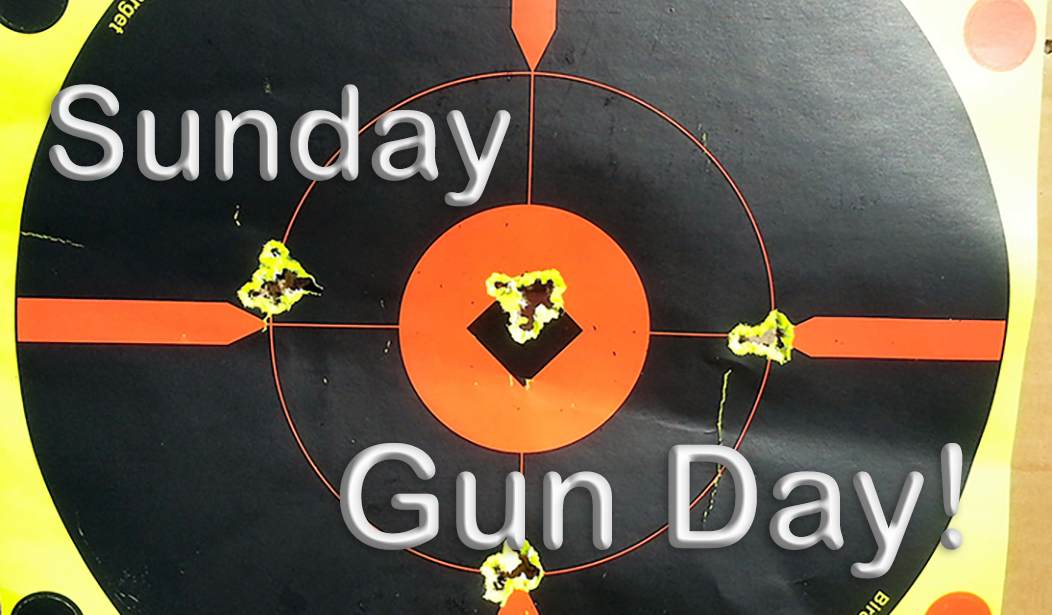While most Sunday Gun Day posts have been about either the technical aspects of certain firearms or the history of guns in general, we have neglected to discuss some of the uses to which firearms are put, one of which is pest control. One of the more common pests around the United States right now is the common coyote, and while plenty of folks have made a specialty of hunting old Wile E., my experiences with them put some of my shooting skills to the test – a test which the coyotes have won.
The Critters
You all know what coyotes are. Technically a small wolf and holder of the same ecological niche in North America as the golden jackal in Eurasia, Canis latrans is nowadays ubiquitous across North America, but when I was a kid back in my folks’ place on Bear Creek in Allamakee County, Iowa, they weren’t nearly as common.
Back in those days (the mid-to-late Seventies) in those hardwood-covered hills of northeast Iowa, we had a few bobcats around, and occasionally a bear or mountain lion would wander in from Minnesota or Wisconsin. We once even had a small wolf pack move into the area for part of the winter. But coyotes were a thing of the West, of open prairies. Our primary predators ran more to hawks, owls, raccoons, foxes, minks, skunks, weasels, and the occasional feral housecat.
Note one thing some of those critters have in common. Some of them – raccoons, foxes, and minks – had fur that was valuable in those days. Hunting and trapping them, along with muskrat and beaver, kept me in pizzas and shotgun shells during much of my misspent youth.
Mind you, the wildlife picture then was different in other ways. Wild turkeys were being slowly re-established all over the Midwest. When I was a little tad seeing a deer was unusual enough to prompt some excitement, although by the time I was in high school, they were approaching their current semi-pestilential status.
It was around that time that coyotes started to establish themselves in the area.
Their Arrival
When coyotes came to the area around Bear Creek, they announced their presence with a serenade – sort of.
Lots of city folks seem to think that the woods are silent at night. Ours weren’t. In the summer, up on the tall oaks at the top of the hills and ridges, barred owls would gibber, shriek, and wail. Evenings and early mornings whippoorwills would call from the brush, and in the spring, woodcock would peent in the edges of the meadows and do their twittering, corkscrew mating flights. Deep in winter great horned owls and long-eared owls would issue their deep hoots from deep in the darkest parts of the forest.
In good weather, I sometimes wouldn’t sleep indoors for weeks at a time. In the summer I rarely came in the house at all, except maybe to grab my dinner plate to take out to the picnic table. I often slept in the big tree house my Dad and I had built up in a big box elder hanging over the creek. No little kid’s tree house this, but a big, enclosed, screened-in thing holding a double bed and a small end table; it was even wired for electricity. That’s where I spent many a summer night, listening to the owls and the whippoorwills. And that’s where I was the first time I heard a coyote howl.
Almost 50 years have passed but I still remember it very well. It was maybe an hour after sunset, and I’d been lying in the tree house, reading something or other and listening to a whippoorwill call across the creek. That’s when I heard it, a yapping howl coming down through the woods from one of the meadows.
That first coyote song only lasted a few moments, with one coyote answering the first until down the road my brother’s old farm mutt started barking at the noise. The coyotes fell silent, but I wasn’t the only one that had heard them.
The next morning, I climbed down from the tree house and went inside looking for breakfast to find the Old Man at his usual morning spot at the kitchen table with his coffee. “Did you hear the howling last night?” I asked.
“Coyotes,” he agreed. “They’ll be hard on the grouse and turkeys,” he predicted. These were in the days, at least in northeastern Iowa, when people took a more practical attitude towards wildlife.
See Related: Drunk Man Decides to Kick a Bison in Yellowstone, Learns About Consequences
He was right. Wild turkeys are big enough to resist a coyote after their nest, but our ruffed grouse population started to suffer almost immediately after coyotes started moving in; the prairie wolves were hard on the ground-nesting game birds’ efforts at reproduction. But that first morning, with the memory of that howl still fresh, my teenaged mind immediately turned to face another problem: Come winter, how best to gather prime coyote pelts?
The Problem of Control
Come early winter when pelts are prime, I looked to my tools for harvesting them. I had a pretty good string of traps and a new Marlin .22 Magnum rifle that was a real tack-driver. Also in the tool kit was a selection of predator calls, wood, and plastic calls intended to imitate the sound of a rabbit, bird, or mouse being slowly eaten alive.

My traps were by far the more productive means. All my efforts at predator calling over the four or five years I’d been trying it at that point had yielded precisely two gray foxes, while my trapline yielded a regular supply of muskrat and raccoon pelts, and occasionally a fox or mink. In those days, green muskrat pelts were going for from two to four dollars, while a raccoon would net you from twenty to thirty dollars. A prime red fox would grab you fifty bucks if it was in good shape – serious money for a fifteen-year-old country kid in the mid-‘70s. A mink would get you that much, maybe ten more if it was a big buck with prime fur.
One time when I was in town selling off a half-dozen or so muskrat pelts, I asked the old man who bought furs from farm kids all around how much he’d give for a coyote pelt.
“Prime winter pelts?” he looked thoughtful for a moment. “Not in as much demand as a fox, but, oh, I suppose forty bucks or so.”
That was enough to get me interested in taking coyotes. The problem is, that would prove easier to imagine than to do.
That first fall I took a good look at my trap string with coyotes in mind. Most of my lot was #1 and #2 long spring and coil spring traps. A #1 is great for muskrat and a #2 will take a raccoon or fox, but I needed a #3 for coyotes, so the next time I went to the fur buyer, I sunk the money from a couple of raccoon pelts and a few muskrats into three #3 coil spring traps. I took them home, boiled them, let them gather a little patina (traps shouldn’t be shiny), waxed them, and started thinking about how to trap coyotes.
I tried the works. Pit sets and cubbies baited with carp from the creek or squirrel guts, trail sets, and scent lures. All I netted were raccoons.
I tried wandering the hill with predator calls and a rifle, finding good places to hide and calling. I tried every predator call I had, every variation on a call I could think of. I tried to make every call sound as though blood was literally dripping, but the coyotes obviously saw through that.
In those years, I didn’t yet appreciate how canny a little song-dog could be. But while I couldn’t call coyotes with any success, some other folks in the area were learning the art.
How It Was Done
Spring came soon enough.
It’s important to remember that in those years, I was, probably because of some misdeed early on in my career, sentenced to serve Monday through Friday in a tedious occupation called “school.” “School” was supposedly preparing me to be a functional adult but was mostly seriously cutting into my hunting and fishing time.
So, it was a Saturday afternoon that found me wandering around the countryside between several of my favored fishing spots when I stopped in at the little village of Highlandville for some gasoline and a bottle of pop.
See Related: The Story a Black Rock Told Me on a Montana Mountain
Old Myron Petersen, who ran the general store in Highlandville, was familiar with my efforts to take coyote pelts and so asked me how the winter’s effort had gone.
“Nothing,” I admitted. “Can’t trap ‘em, can’t call ‘em.”
Now it happened that on this afternoon, ensconced on the old bench on the decking in front of Petersen’s General Store, was an old man whose name slips my mind at this distance in time but who I do remember was a cousin of the expansive Hamill clan who owned great swathes of farmland in Winneshiek and Allamakee counties. I noticed him paying attention to my admission of failure, and he spoke up as I started down the stairs to my truck.
“You can’t call coyotes?” he asked.
“Never had any luck,” I admitted.
“Could be that you’re not doing it the right way,” the old man said. “Using store calls?”
“Yup.”
“See, that’s the problem. I’ve called in a few coyotes. Yessir, called in a few. Just use a big blade of grass.”
“Bulls**t,” I opined.
“Nope. No BS. I can show you, if’n you want.”
I looked to the west. The sun was growing low in the sky. Not a bad time to be set up to call predators. Now, in early summer, pelts wouldn’t be worth anything, but at least I figured I might learn something. Still, I was skeptical. “All right,” I said. “but I don’t think you can do it.”
“Well, boy, you want to put a bet on that?”
We agreed on five dollars, a not-insubstantial bet in those days. After securing Myron Petersen’s permission to walk through his timber to a big meadow at the top of the hill, I suddenly remembered that my tack-driving .22 Magnum was back at the house.
I wasn’t completely unarmed. Before we set out, I opened the truck’s toolbox and extracted the one firearm I had with me that day, an old replica .36 caliber 1851 Colt Navy. I loaded the gun, belted it at my waist, and off we went.
It took maybe half an hour to get in place. “Set yourself down there,” the old man pointed, “just behind them raspberry brambles. I’ll be right behind you here.” He sat down with his back against a big oak tree on the edge of a large meadow. What he did next was remarkable.
After a moment’s careful study of the tall meadow grasses around him, the old man pulled off a long, broad strand. He ran it between his work-hardened old fingers a couple of times, stretched the blade tight in between his two cupped hands, raised his hands to his mouth, and blew.
A piercing, awful shriek resulted. He blew a prolonged blast, then another.
“Now we wait for a spell,” he whispered. This was something I was familiar with; patience is essential in hunting and fishing.
We waited maybe fifteen minutes. I was beginning to doze when the old man let out another horrible shriek with his grass blade, startling me almost upright.
This went on until it was growing dark. The cardinals, always the last birds go to roost, were chirping their good nights in the woods, when I heard the old man let out a sharp hiss. “Look there,” he said, “over t’the right.”
Where the tree line curved around the big meadow to the right, a big dog coyote stood maybe a hundred yards away, eyes, ears, and nose focused on our position.
The old man let out a quiet, subdued squeak with his grass blade.
The big dog coyote trotted maybe another thirty yards closer, all his senses focused. I raised my head a little to get a better look; he saw the movement, tensed to run…
…it was a long shot, but it was all I was going to get. I jumped to my feet with the speed borne of youth, yanked the old Navy .36 from its holster, and loosed three booming shots at the coyote as he swapped ends and made for the horizon. When the black-powder smoke cleared, I saw the coyote disappear into the woods, ears and tail held high, running well, unscathed.
After the old man finally stopped laughing, he looked at me with a big grin, “Well, boy,” he demanded, “you ain't forgot that bet, have you?”
I hadn’t. I handed him a fiver; we walked back down to Petersen’s store, where old Myron and his wife Esther were sitting on the front deck awaiting the outcome. They’d heard the shots and were amused to hear of my three clean misses. The old man took my five dollars, bought a twelve-pack of Miller High Life from Myron, and disappeared into the dark. I stowed the old Navy sixgun back in the toolbox, climbed into my truck, and went home. I never did kill a coyote in northeast Iowa.
As It Stands
While the coyote isn’t found often in Alaska, I still spend some time in Colorado mooching around in the mountains from time to time, where there are a lot of them. As I’ve grown older, I haven’t tried hunting them again. I enjoy hearing them sing at night when I’m bumming around in the mountains (to evade suspicion, I usually describe my woods-bumming as “hunting” or “fishing” to make it sound like I’m doing something worthwhile), and I find their quick-witted, adaptable presence in my former stomping grounds something to be appreciated.
I like coyotes. They’re great survivors. They may well be around after we’re gone. And from my brief experience trying to hunt and trap them, I can sure see why.














